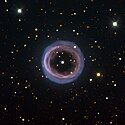Shapley 1
| Planetarischer Nebel Shapley 1 | |
|---|---|
 | |
| Aufnahme des New Technology Telescope am La-Silla-Observatorium in Chile | |
| AladinLite | |
| Sternbild | Winkelmaß |
| Position Äquinoktium: J2000.0 | |
| Rektaszension | 15h 51m 41,0s [1] |
| Deklination | −51° 31′ 28″[1] |
| Erscheinungsbild | |
| Scheinbare Helligkeit (visuell) | 12,6 mag |
| Winkelausdehnung | 1,2′ × 1,2′ |
| Zentralstern | |
| Bezeichnung | Gaia DR3 5982072132545824128 |
| Scheinbare Helligkeit | 14,0 mag |
| Physikalische Daten | |
| Entfernung | 4542 ± 106 Lj |
| Alter | 7.800 Jahre |
| Geschichte | |
| Entdeckung | Harlow Shapley |
| Datum der Entdeckung | 1936 |
| Katalogbezeichnungen | |
| PK 329+02.1 • PN G329.0+01.9 • ESO 225-PN2 • IRAS 15479-5122 | |
Shapley 1 (Sp 1 oder PN G329.0+01.9)[2] ist ein ringförmiger planetarischer Nebel im Sternbild Winkelmaß,[3][4] der ungefähr 4.500 Lichtjahre entfernt ist. Er hat eine Winkelausdehnung von 1,1 Bogenminuten,[5] was unter Berücksichtigung der Entfernung einem Durchmesser von einem Drittel Lichtjahr entspricht. Im Zentrum befindet sich ein Doppelsystem mit einer Umlaufdauer von 2,9 Tagen.
Shapley 1 wurde 1936 von Harlow Shapley entdeckt und katalogisiert.[2][3]
Literatur
- König, Michael & Binnewies, Stefan (2023): Bildatlas der Sternhaufen & Nebel, Stuttgart: Kosmos, S. 248
Weblinks
astronews.com: Bild des Tages 12. August 2011
Einzelnachweise
- ↑ 225-PN2 SIMBAD
- ↑ a b Shapley1. Astrosurf, abgerufen am 12. Oktober 2009.
- ↑ a b Darling, David: Shapley 1. In: David Darling Encyclopedia. Abgerufen am 21. Oktober 2009.
- ↑ The planetary nebula Shapley 1. In: Image Catalogue. Anglo-Australian Observatory, archiviert vom am 15. Februar 2014; abgerufen am 21. Oktober 2009.
- ↑ http://www.daviddarling.info/encyclopedia/S/Shapley_1.html
Auf dieser Seite verwendete Medien
Autor/Urheber: ESO, Lizenz: CC BY 3.0
The hazy and aptly named Fine Ring Nebula, shown here, is an unusual planetary nebula. Planetary nebulae form when some dying stars, having expanded into a red giant phase, expel a shell of gas as they evolve into white dwarfs. Most planetary nebulae are either spherical or elliptical in shape, or bipolar (featuring two symmetric lobes of material).
But the Fine Ring Nebula — captured here by the ESO Faint Object Spectrograph and Camera mounted on the New Technology Telescope at the La Silla Observatory in Chile — looks like an almost perfect circular ring. Astronomers believe that some of these more unusually shaped planetary nebulae are formed when the progenitor star is actually a binary system. The interaction between the primary star and its orbiting companion shapes the ejected material.
The stellar object at the centre of the Fine Ring Nebula is indeed thought to be a binary system, orbiting with a period of 2.9 days. Observations suggest that the binary pair is almost perfectly face-on from our vantage point, implying that the planetary nebula’s structure is aligned in the same way. We are looking down on a torus (doughnut shape) of ejected material, leading to the strikingly circular ring shape in the image.
Planetary nebulae are shaped by the complex interplay of many physical processes. Not only can these celestial objects be admired for their beauty, but the study of precisely how they form their striking shapes is a fascinating topic in astronomical research.
This image was made using multiple filters: light observed through B and O-III filters is shown in blue, V is shown in green, R is shown in orange, and H-alpha in red. The image is approximately 200 arcseconds across.